Just in time for the Small Press Expo, I have dedicated my final entry in this year’s “What You May Have Missed” article series to a variety of excellent comics that were either self-published or released by small publishers. As with my previous entries, I hope that this entry allows readers the chance to find and support delightful comics that may have otherwise escaped their notice.
The majority of these comics are intended for a young adult audience, personally recommended at about 13 years of age or older. The final three books are recommended for adult audiences as they contain graphic content in terms of sexuality and/or violence. Overall, these comics cover a variety of themes, art styles and subject matter, and are an excellent showcase of what the medium can accomplish in terms of art and storytelling.
Young Adult:
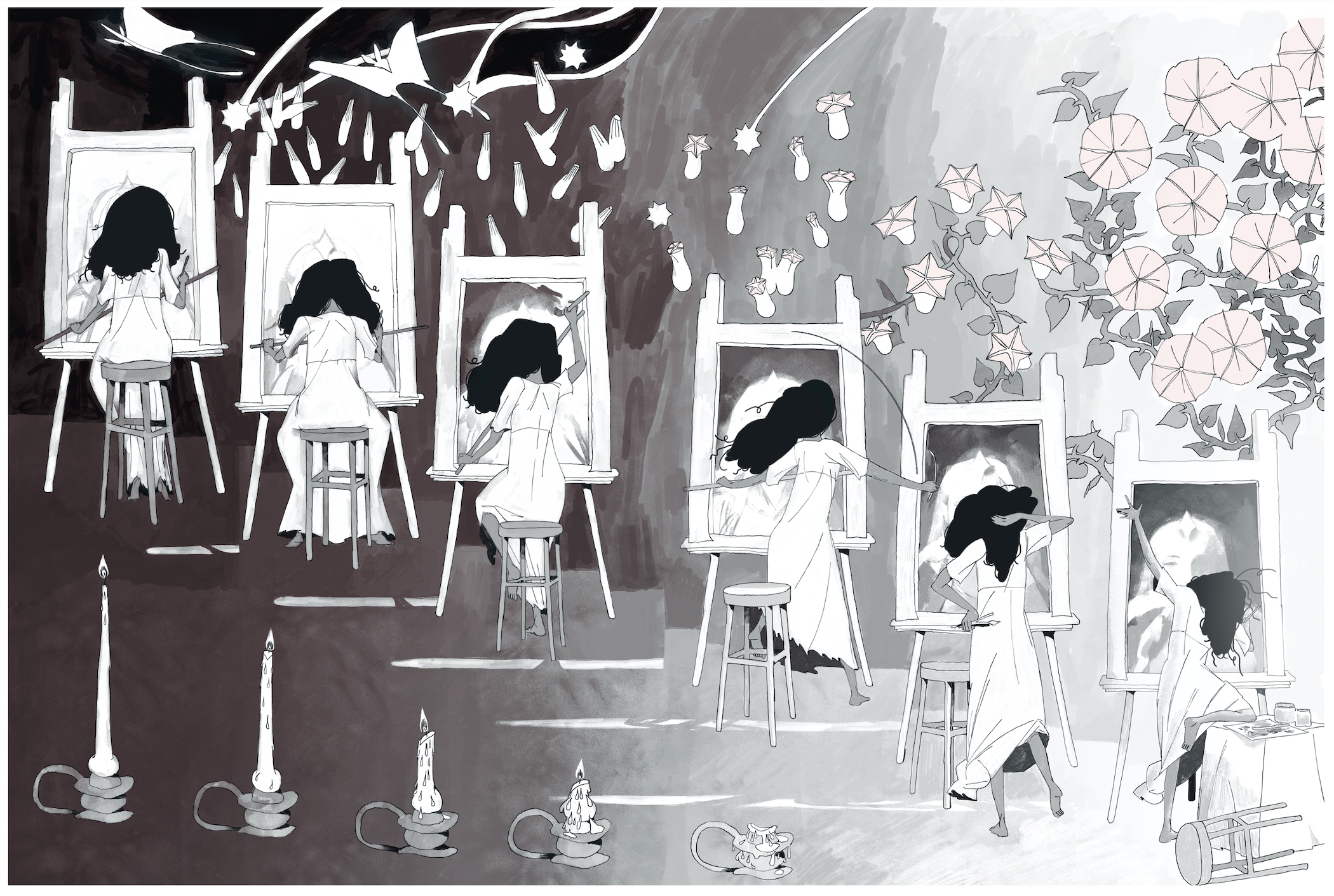
A splash page for the comic “Canvas” by Theo Stultz. The spread depicts a woman in a white dress going through the process of painting a portrait, with six different drawings showcasing the various stages of her creative process. As time passes, she goes from sitting on her chair in a poised posture to abandoning the chair entirely, and her body language becomes increasingly animated with each drawing. A series of five melting candles in the bottom left corner illustrates the passage of time, as does the gradual blooming of morning glories in the upper right corner of the page.
In this delightful original fairy tale, a young painter finds it difficult to pursue her passion, as it is tricky to create compelling art without any models. Desperate, she tosses her baby teeth into her family’s well to make a wish. The results were immediate and unexpected. With delightful characters and a fun art style, this one is not to be missed by those who love fairy tales.

The cover of the comic “Electro Magnetic Bottle Rocket” by Francesca “Fums” Lloren. The cover depicts two women standing on top of a pile of scrap metal. The woman on the left has short black hair, wearing a red sleeveless top and black jeans. The woman on the right has short, spikey Munsell green hair that resembles a thunderbolt in the back, wearing a black t-shirt with brown slacks. Above them, a bottle rocket is being propelled in the sky, leaving behind a trail of water. They are surrounded by a boreal forest and mountains
The Comics of Francesca “Fums” Lloren (Fums’s website)
Several amazing comic talents emerged during the pandemic, and Francesca “Fums” Lloren is certainly one to keep an eye on. Making their comics debut in 2020 with their shonen manga-inspired oneshot Knightbreakers, Fums has since released a variety of excellent comics that feature dynamic characters, memorable worlds, and excellent panel work for both action-heavy and slice-of-life scenes. I look forward to reading their future comics and seeing how their talent grows.

The cover of the manga “Invisible Parade” by MISSISSIPPI. The manga’s title is only partially visible as the rest wraps around to the back of the book. The cover depicts a lake, the surrounding shoreline and foliage, and a partial building in the upper right corner. The entire cover is painted with watercolours.
Invisible Parade by MISSISSIPPI
(Translators: Anna Schnell, Emuh Ruh, Jocelyn Allen, Jun Kitamura, Andy Jenkins, & MISSISSIPPI. Letterer: Tim Sun. Design, Editing & Layout: Emuh Ruh. Published by Glacier Bay Books)
MISSISSIPPI’s Invisible Parade is a delightfully bizarre assortment of manga, where the strange is familiar and the familiar becomes strange. Using a variety of different art styles to depict a vast array of stories that combine speculative fiction with slice-of-life with ease, this is a collection not to be missed by comics fans. Also, I have this manga to thank for introducing me to one of my new favourite songs, which is frankly a delightful bonus in my books. It is also available digitally through Azuki’s website and app.
NOTE: According to the publisher this comic is reaching the final copies for its print run, and there are no plans for a second printing, so if you want to read this book I would suggest picking it up sooner rather than later
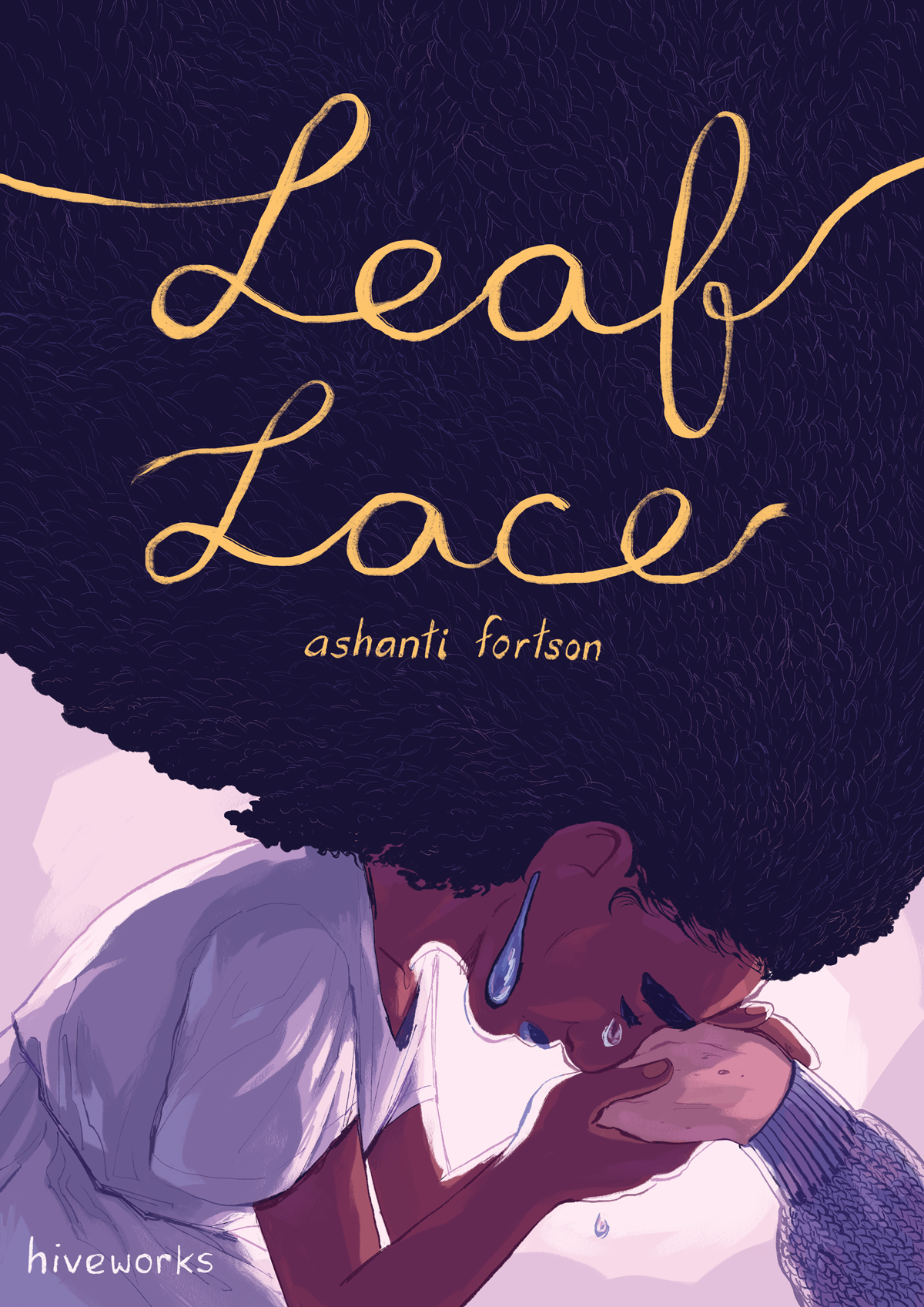
The cover of the comic “Leaf Lace” by Ashanti Fortson. The cover depicts a woman crying, as she presses her face into the hand of another woman who is not entirely visible. The woman crying appears to be an adult unmarked by age, while the hand is visibly aged with age spots across the hand. The hair of the woman crying is styled like woven threads, and the elderly woman is wearing a purple sweater.
Winner of the 2021 Ignatz Award for “Outstanding Comic”, Leaf Lace shows the life of the eon’s old Ananke and her mortal lover Mnimi, as Mnimi reaches the last day of her life. A poignant comic about the importance of letting go and moving forward in life after losing those you love the most.
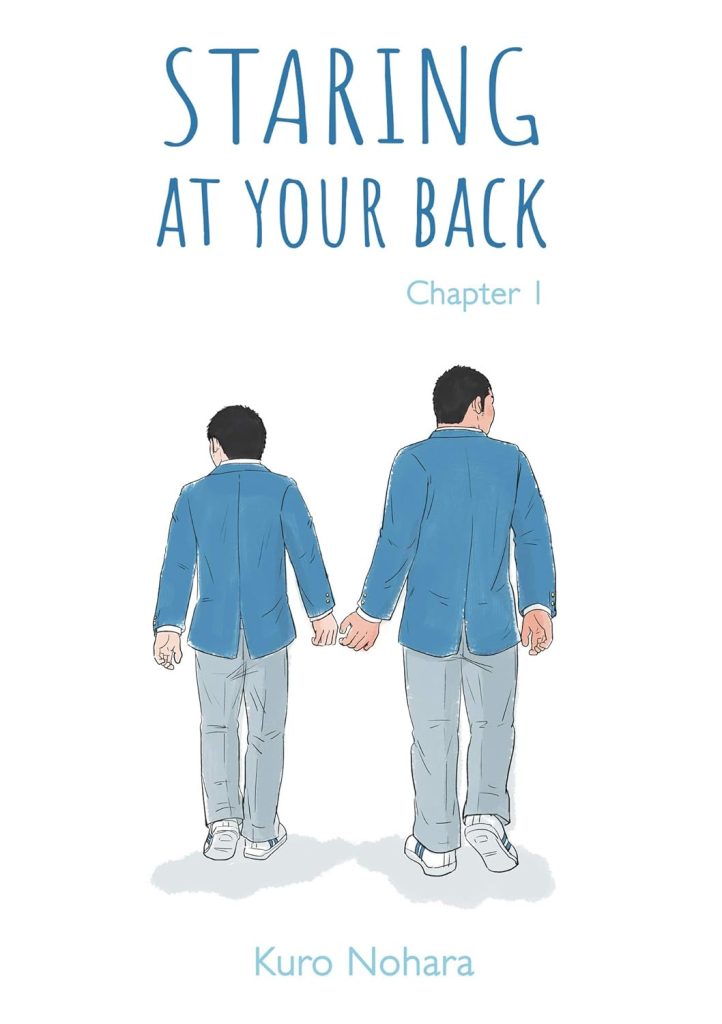
The cover of the first chapter of the manga series “Staring at Your Back” by Kuro Nohara. The cover depicts two Japanese high school students, both boys, walking next to each other, their backs to the audience. They are looking away from each other, and yet their hands are drifting close to each other, indicating the mutual longing between them.
Staring at Your Back by Nohara Kuro (Translators: Jordan Sinnes & Laura Negro. Published by Éditions Akata)
Content warnings: Homophobia and transphobia
The English debut of gay manga artist Nohara Kuro, Staring at Your Back follows the life of Takeru, a gay high school boy living in a conservative small town where everyone is expected to get married and have kids. When his childhood friend, Kotaro, suddenly transfers to their school Takeru finally finds someone he can be honest about who he is. A bittersweet, but generally hopeful, LGBTQ+ manga. Hopefully, more of Nohara’s manga will get translated in the future.
NOTE: The English edition of the manga is only available digitally, while the French edition (Mes yeux rivés sur toi) is available in both digital and physical formats.

The cover of the manga “The Karman Line” by Mitsuhashi Kotaro. The cover takes place in the middle of a large body of water, where two people are sitting in a rowboat, watching an object fall out the the sky and land into the water ahead of them. The cover only uses various shades of indigo and white for colours. The art style emphasizes soft lines, as well as delicate light and shading.
The Karman Line by Mitsuhashi Kotaro
(Translator: zhuchka. Letterer: Tim Sun. Editor & Designer: Emuh Ruh. Published by Glacier Bay Books)
Mitsuhashi Kotaro’s The Karman Line examines a variety of dreamy scenarios that are both comforting and melancholic. Using soft lines and indigo blue-and-white colours, the manga invokes a feeling reminiscent of a lucid dream that sticks in your mind after waking up, or a picture book from your childhood that you remember fondly even if you have long since forgotten its name. A delightful exploration into the possibilities of independent manga, and comics in general.
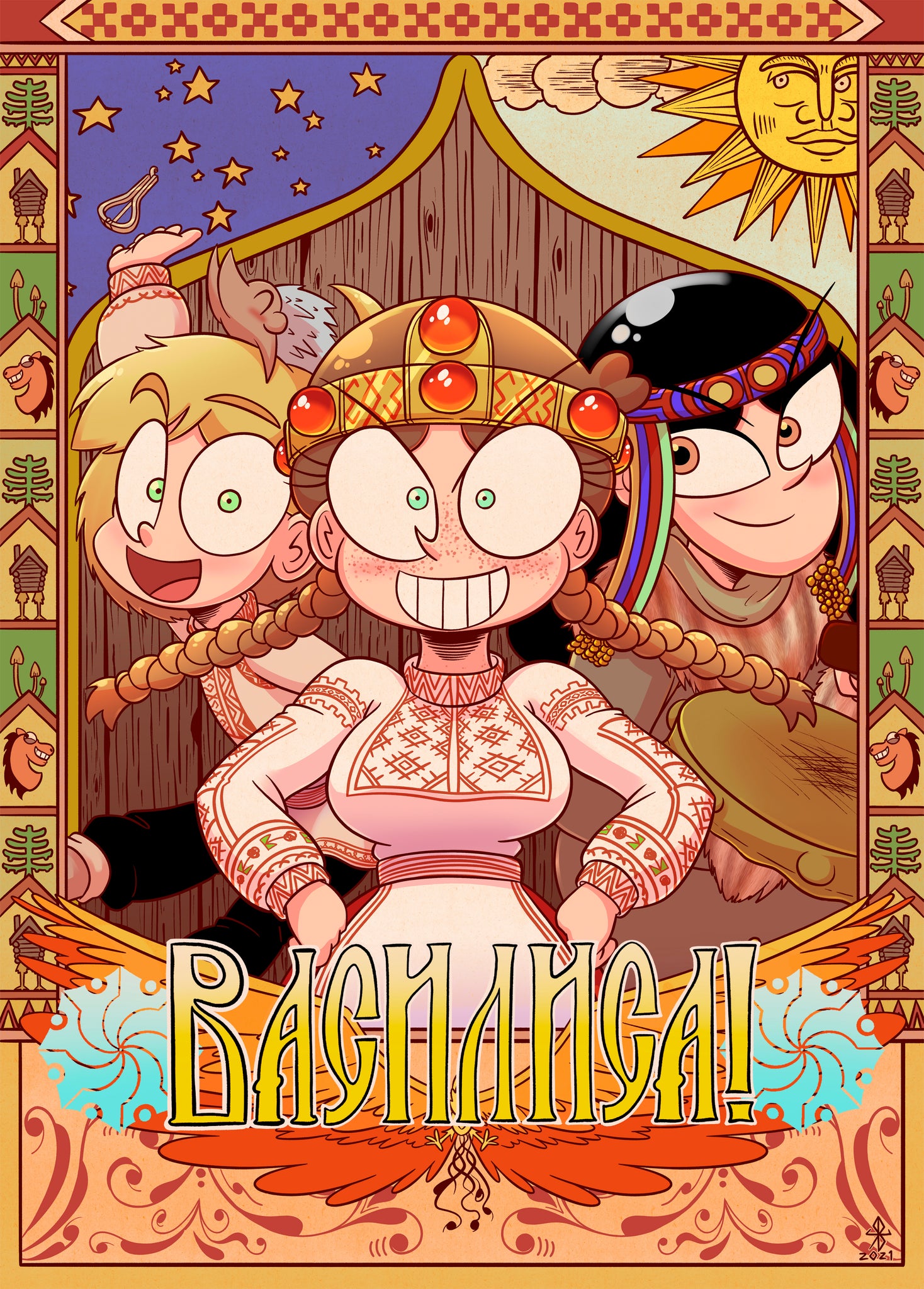
The cover of the manga “Vasilisa! The Wise Princess & Other Classic Folktales” by Kuraibe Keishi. The cover has three young people, two girls and a boy, in the middle, with a hedgehog sitting atop the boy’s head. The girl in the center is wearing a golden crown with red jewels, while the girl on the right is holding a frame drum and wearing the garb of Slavic shamans, while the boy on the left is holding a jaw harp in his right hand. The word “Vasilisa” is written in Cyrillic at the bottom of the title, framed by the orange wings of a firebird.
Vasilisa! The Wise Princess & Other Classic Folktales by Kuraibe Keishi
(Translator: Dan Luffey. Letterer & Retouching: Meg Argyriou. Project manager: Matt Haasch. Published by Star Fruit Books)
Vasilisa is a delightfully unique manga full of passion and love for its subject matter. The story is an adaptation of numerous folk and fairy tales of Eastern European origins, combined with the action-comedy storytelling sensibilities of shonen manga, and an art style inspired by American cartoons. Kuraibe clearly loved making this manga, from the drawings to the immense amount of research he undertook to create it, his ability to translate those passions into such a fun story is admirable. Highly recommended for folk and fairy tale lovers.
Adults Only:
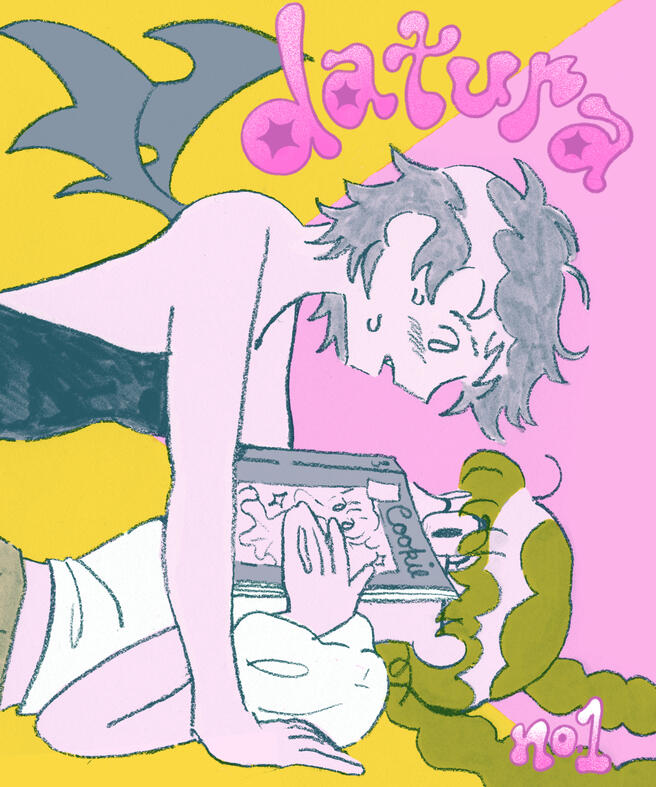
The cover, by Steph Bulante, of the first issue of the comic anthology magazine “Datura”. It has two women, one lying on the ground, and the other on top of her, bracing her hands on the ground on each side of the other woman’s arms. The woman on top has bat-like wings, short hair, and is blushing and sweating with attraction or embarrassment. The girl on the bottom is wearing glasses and has braided pigtails, holding a magazine called “Cookie” up to her face to hide the lower half of her face.
Datura Issue 1, Stories by Pa-Luis, Emma Jayne, Mar Julia, & Cathy G. Johnson. Edited by Sunmi & Mar Julia. Cover art by Steph Bulante
Content warning from the publisher: Body horror for Cathy G. Johnson’s story “Body Count”, which is a story intended for readers aged 18+
A self-described “josei-inspired queer anthology…[aiming] to expand on ideas of “Girl’s Love”” the debut issue of Datura magazine presents four unique comics that each explore sapphic relationships and the complexities therein. The comics are all clearly loving homages to manga created for women while, simultaneously, allowing each of the artists’ unique creative voices to shine through. Sometimes melancholic, sometimes humorous, sometimes creepy, overall an excellent showcase of comics. I’m looking forward to seeing what this magazine has to offer in future issues.

The cover of the graphic novel “Matchmaker” by Cam Marshall. The cover has three twenty-something adults standing on the cover. The gender non-conforming woman on the left has long dark-brown hair, is wearing a brown knit cap, a black t-shirt and glasses, lovingly hugging the person in the middle; the non-binary person in the middle has short pink-dyed hair with pigtails and is wearing a purple sweater, lovingly hugging the person on the left; the man on the right has short brown hair, and a beige knitted sweater, and is giving the person in the middle “bunny ears”.
Matchmaker by Cam Marshall (Published by Silver Sprocket)
Matchmaker follows the life of several queer twenty-somethings doing their best to navigate their lives as they make connections, find romance, and wade through a shitty job market, all while dealing with the ongoing COVID-19 pandemic. While the comic does not pull any punches in regards to how shitty the pandemic is, and how shitty some people have behaved in response to it, the overall message is one of finding hope, happiness and community in a shitty situation. Plus, there’s a great deal of unabashedly queer humour that is refreshing and hilarious.
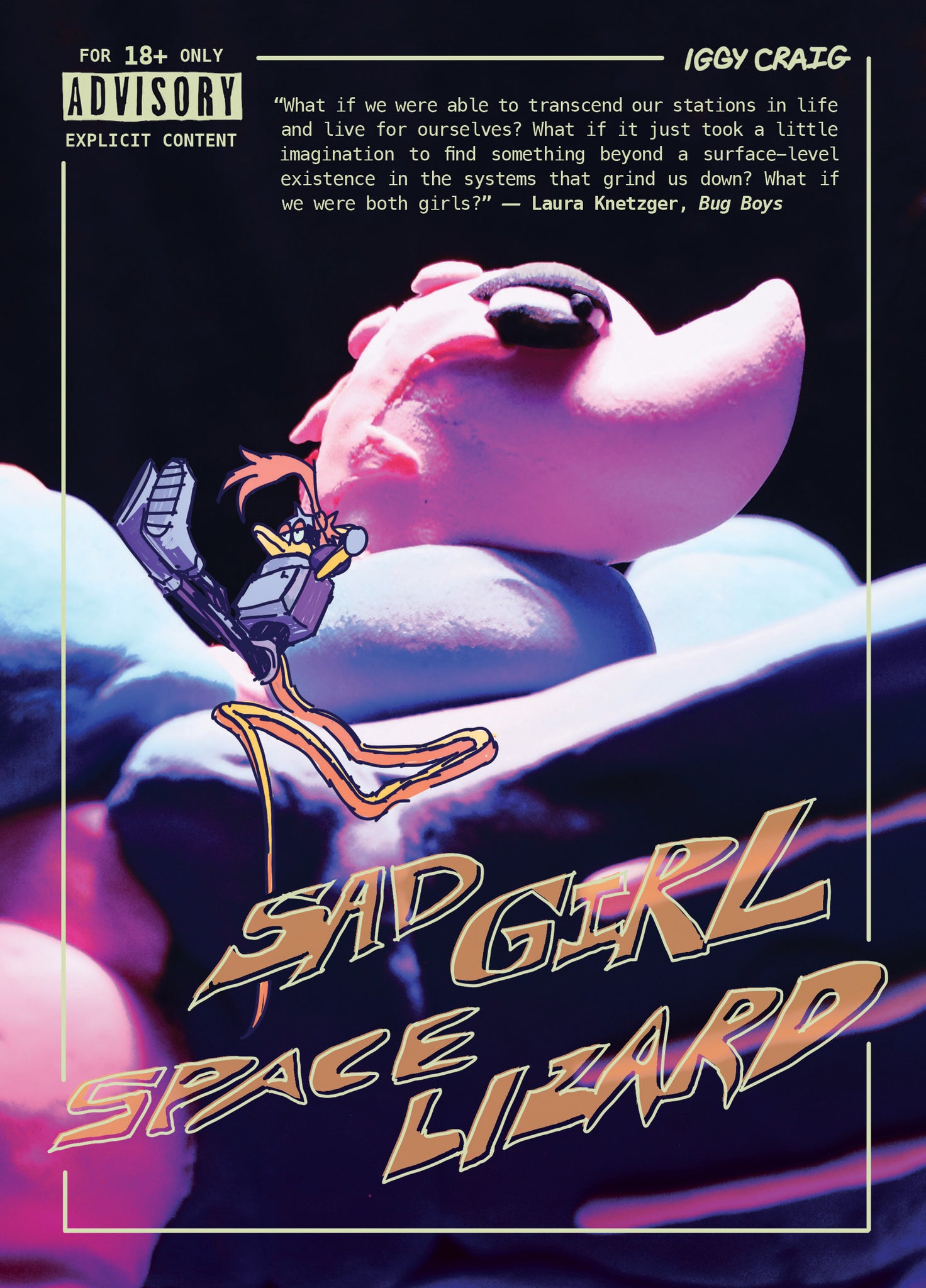
The cover of the graphic novel “Sad Girl Space Lizard” by Iggy Craig. The cover has a plasticine figure of an anthropomorphic lizard woman, with pink scales and body armor. On her right shoulder is a drawing of an anthropomorphic lizard woman, with yellow scales, salmon-coloured hair, and body armor.
Sad Girl Space Lizard by Iggy Craig (Published by Silver Sprocket)
Content warnings from the publisher: Depictions of sex, nudity, crude language, and alien violence. It is intended for readers 18+ only.
Sad Girl Space Lizard delivers not only its title thesis, being about two sad lizard girls in space, but also on creating a unique sapphic mech story. The story follows Lieutenant Left who works maintenance on a space-travelling battle mech, alongside the highly esteemed Commander Right, who is also her only other crewmember. Her life is very boring and routine until one day Right gets injured and can no longer pilot their mech, causing them to work together in order to survive on their own in space. Left and Right are both intriguing characters with their own baggage to sort through, and their relationship feels very grounded and relatable despite its fantastical setting and characters.
Image Sources: All images of these comics belong to their respective artists and publishers. Creators and publishers are free to contact me if they wish to have the entry discussing their work edited, or removed, or to have any image descriptions edited or changed for clarity.